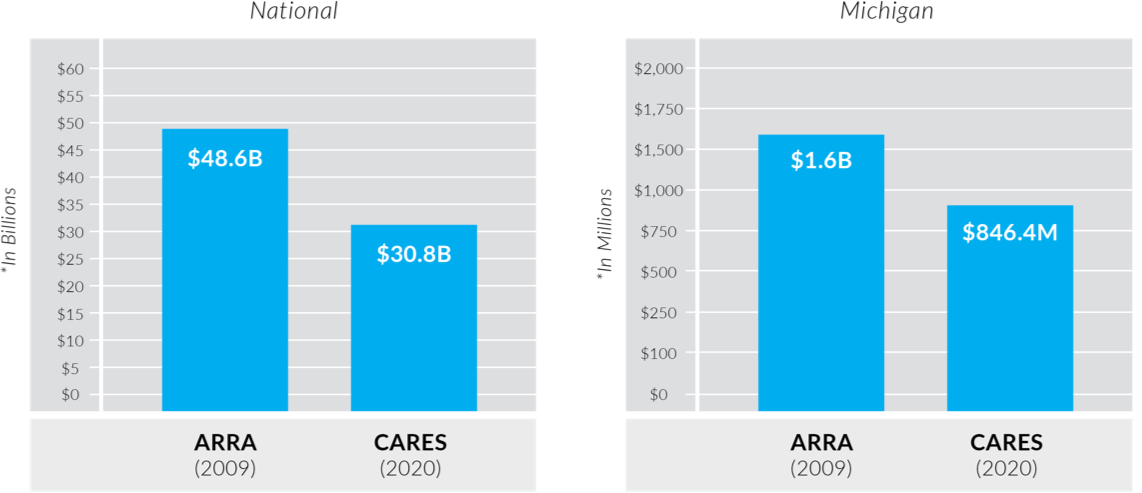The coronavirus is likely to balloon into the worst financial crisis since the Great Depression, and its impact is being felt especially on public schools. In the coming year and beyond, the financial damage to public schools could wind up being historically unprecedented.
The COVID-19 crisis is already surpassing the Great Recession after just two months. Unemployment rates topped 10% during the Great Recession in 2009, and peaked during the Great Depression at 24.9%. Unemployment is likely at 18% today, (some experts believe after data released this Thursday that the unemployment rate is actually higher than 20%), higher than the peak of the Great Recession. The Federal Reserve estimates that it could explode to an unprecedented 32%.
To be sure, the most immediate financial effects of this crisis will be felt at dinner tables before they’re felt in the classroom. In Michigan, roughly a quarter of the state’s workforce “is now trying to obtain unemployment aid.” But the downstream impacts of high unemployment will cascade into a budgetary crisis for the states, which will inevitably force states like Michigan to slash services and other expenditures. The Great Recession caused a 9% drop in state tax revenue in one year.
It’s an unfortunate reality that public services will be on the chopping block as Lansing and Washington, D.C. weigh what to prioritize as we weather this storm, so we have to wonder: “How badly will individual states like Michigan be impacted, and where will the cuts be made?”
Historically, as state revenues declines, “hefty cuts” are made to public education; and although Congress addressed education funding in its latest stimulus package, there are very serious concerns that it does not go far enough to help states fund their public schools.
What is congress doing about it?
The current CARES aid package has received a lot of media attention, but we’re left wondering if it does enough for the public education in Michigan and across the nation. The CARES Act, passed almost unanimously and is the largest stimulus package in history. But out of the roughly $2.2 trillion dollars in the package, only $30.75 billion dollars went to the Education Stabilization Fund, which translates to only about 1.4% of the entire aid package. Only $13.5 billion of that went to K-12 public schools.
2009 ARRA vs 2020 CARES Education Stabilization Fund

It’s true that prior stimulus packages were much smaller, but they provided significantly more funds for education. The 2009 American Recovery and Reinvestment Act (ARRA) allocated about 100 billion dollars to education, which was more than one eighth of the entire bill. Compared to these prior bills, public schools are receiving less aid than before, and as a result, students could go without the necessary tools to succeed in this crisis and in its aftermath.
What does this mean for Michigan children?
At first glance, Michigan’s portion of the aid package, $846.4 million, appears to be a large share; however, Michigan actually receives educational aid roughly proportional to its share of the national student population. But in reality, institutions and young students that need aid the most will only see a small portion of that.
Michigan’s K-12 programs will receive only $410.5 million; there were 1.4 million students who enrolled in public K-12 programs in 2019, which means in the face of the COVID-19 crisis, the state is only receiving an extra $293 dollars per student. In some states, including Michigan, the CARES Act will not meet the needs of already strained public education systems hurt by a variety of factors including declining enrollment and a tightening economy.
These needs are especially pronounced in rural Michigan, where challenges inherent to rural life push school budgets and access to resources to the limit. For example, the Northern Michigan Tahquamenon area school district needs to spend 9% of its total budget on transportation simply bringing students to and from class. As a result of these existing budget challenges, these students are denied most extracurriculars. For rural schools, the CARES Act also fell short of providing adequate funding to ensure children have access to the internet and remote learning, a longstanding problem in rural Michigan. As revenue continues to decline in the aftermath of COVID-19, challenges will rise for rural students.
Looking ahead
As congress weighs additional aid packages, there will be a looming question about whether Congress and the Education Department are taking the necessary steps to ensure Michigan’s 1.4 million public K-12 students in areas such as Tahquamenon and beyond receive the resources and support needed now and in the future. There are enormous economic headwinds ahead for the nation and our public schools.